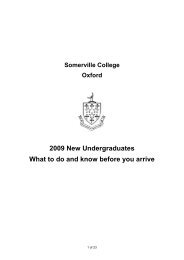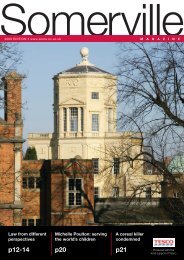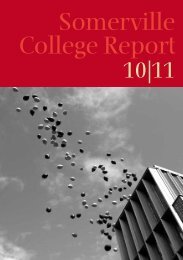International Earth system expert workshop on ocean stresses and ...
International Earth system expert workshop on ocean stresses and ...
International Earth system expert workshop on ocean stresses and ...
Create successful ePaper yourself
Turn your PDF publications into a flip-book with our unique Google optimized e-Paper software.
5To provide more informati<strong>on</strong> <strong>on</strong> how this might best be d<strong>on</strong>e, CUPE commissi<strong>on</strong>ed asec<strong>on</strong>d research report in 2003, by ec<strong>on</strong>omist M<strong>on</strong>ica Towns<strong>on</strong>, <strong>on</strong> the investmentof pensi<strong>on</strong> funds in public infrastructure.The study begins with a str<strong>on</strong>g asserti<strong>on</strong> of the importance of public infrastructure,<strong>and</strong> the serious ec<strong>on</strong>omic costs of its erosi<strong>on</strong>.“It has been suggested that the slowdown in public infrastructure investment canhelp explain a significant porti<strong>on</strong> of the slump in productivity growth in the pasttwo decades. Public investment in infrastructure is also critical to ec<strong>on</strong>omicgrowth. But the value of public investment in these public goods such as roads,bridges, recreati<strong>on</strong> centres <strong>and</strong> community facilities, transportati<strong>on</strong>, schools <strong>and</strong>hospitals, does not appear in government accounts…Accounting practices fail toacknowledge the importance of the public assets acquired through publicinfrastructure investment <strong>and</strong> leave the impressi<strong>on</strong> that investment ininfrastructure is simply a “cost” with no “benefit” to show for it.” (p.1)Towns<strong>on</strong> also provides a brief history of infrastructure finance, pointing out that thepost-war “welfare state”, <strong>and</strong> the significant physical capital that came with it (in theform of new hospitals, schools, <strong>and</strong> other public facilities) were generally publiclyfinanced. It has <strong>on</strong>ly been in the past 20 years that this role for government hasbeen significantly withdrawn in resp<strong>on</strong>se to the argument that these public goodsought to be owned <strong>and</strong> operated by the private sector.Towns<strong>on</strong> points out <strong>on</strong>e revealing illustrati<strong>on</strong> of this trend - the amendment of theinvestment policy for the $56+ billi<strong>on</strong> dollar CPP (Canada Pensi<strong>on</strong> Plan) reservefund. From the establishment of the CPP in 1966, this fund was invested entirely inprovincial b<strong>on</strong>ds used to finance local governments, schools, hospitals, universities,roads, <strong>and</strong> other public priorities. The b<strong>on</strong>ds held by the CPP paid a reas<strong>on</strong>able,federal government rate of return. However, in 1998, the federal governmentradically changed this policy by moving into a diversified stock <strong>and</strong> b<strong>on</strong>d portfolioinstead – thereby eliminating <strong>on</strong>e of the largest, proven, public sector infrastructureinvestment mechanisms available. The government attempted to justify this change<strong>on</strong> the grounds that greater income was needed for the CPP fund, to meetdemographic pressures. They said “privatized” fund investment would generategreater returns.The result is that the primary model for pensi<strong>on</strong> fund financing of publicinfrastructure has been deliberately eliminated. Moreover, the decisi<strong>on</strong> wasentrenched in legislati<strong>on</strong>, which makes it harder to change.Towns<strong>on</strong> cites the CPP Investment Board’s policy:“Our legislati<strong>on</strong> specifically prohibits us from engaging in any investmentactivities other than maximizing returns without undue risk of loss.C<strong>on</strong>sequently, we do not select or exclude investments through the applicati<strong>on</strong> of
IPSO <str<strong>on</strong>g>workshop</str<strong>on</strong>g> – summary report 010611Baum & Myers, 2004; Rosenberg et al., 2005; Worm et al., 2006; Myers et al., 2007; Jacks<strong>on</strong>,2008; Baum & Worm, 2009; Ferretti et al., 2010; Hutchings et al., 2010; Ward-Paige et al., 2010;Pinskya et al., 2011).The magnitude of the cumulative impacts <strong>on</strong> the <strong>ocean</strong> is greater than previously understoodInteracti<strong>on</strong>s between different impacts can be negatively synergistic (negative impact greaterthan sum of individual stressors) or they can be antag<strong>on</strong>istic (lowering the effects of individualimpacts). Examples of such interacti<strong>on</strong>s include: combinati<strong>on</strong>s of overfishing, physicaldisturbance, climate change effects, nutrient runoff <strong>and</strong> introducti<strong>on</strong>s of n<strong>on</strong>-native speciesleading to explosi<strong>on</strong>s of these invasive species, including harmful algal blooms, <strong>and</strong> dead z<strong>on</strong>es(Rabalais et al., 2001, 2002; Daskalov et al., 2007; Purcell et al., 2007; Boero et al., 2008; Heisleret al., 2008; Dickey & Plakas, 2009; Bauman et al., 2010; Vaquer-Sunur & Duarte, 2010);increased temperature <strong>and</strong> acidificati<strong>on</strong> increasing the susceptibility of corals to bleaching(Anth<strong>on</strong>y et al., 2008) <strong>and</strong> acting synergistically to impact the reproducti<strong>on</strong> <strong>and</strong> development ofother marine invertebrates (Parker et al., 2009); changes in the behavior, fate <strong>and</strong> toxicity ofheavy metals with acidificati<strong>on</strong> (Millero et al., 2009; Pascal et al., 2010); acidificati<strong>on</strong> may reducethe limiting effect of ir<strong>on</strong> availability <strong>on</strong> primary producti<strong>on</strong> in some parts of the <strong>ocean</strong> (Shi etal., 2010; King et al., 2011); increased uptake of plastics by fauna (Andrady 2011, Hirai & Takadaet al. 2011, Murray & Cowie, 2011), <strong>and</strong> increased bioavailability of pollutants throughadsorpti<strong>on</strong> <strong>on</strong>to the surface of microplastic particles (Graham & Thomps<strong>on</strong> 2009, Moore 2008,Thoms<strong>on</strong>, et al., 2009); <strong>and</strong> feedbacks of climate change impacts <strong>on</strong> the <strong>ocean</strong>s (temperaturerise, sea level rise, loss of ice cover, acidificati<strong>on</strong>, increased storm intensity, methane release) <strong>on</strong>their rate of CO 2 uptake <strong>and</strong> global warming (Lent<strong>on</strong> et al., 2008; Reid et al 2009).Timelines for acti<strong>on</strong> are shrinking.The l<strong>on</strong>ger the delay in reducing emissi<strong>on</strong>s the higher the annual reducti<strong>on</strong> rate will have to be<strong>and</strong> the greater the financial cost. Delays will mean increased envir<strong>on</strong>mental damage withgreater socioec<strong>on</strong>omic impacts <strong>and</strong> costs of mitigati<strong>on</strong> <strong>and</strong> adaptati<strong>on</strong> measures.Resilience of the <strong>ocean</strong> to climate change impacts is severely compromised by the otherstressors from human activities, including fisheries, polluti<strong>on</strong> <strong>and</strong> habitat destructi<strong>on</strong>.Examples include the overfishing of reef grazers, nutrient runoff, <strong>and</strong> other forms of polluti<strong>on</strong>(presence of pathogens or endocrine disrupting chemicals (Porte et al., 2006; OSPAR 2010))reducing the recovery ability of reefs from temperature-induced mass coral bleaching (Hoegh-Guldberg et al., 2007; Mumby et al., 2007; Hughes et al., 2010; Jacks<strong>on</strong>, 2010; Mumby &Harborne, 2010) . These multiple stressors promote the phase shift of reef eco<str<strong>on</strong>g>system</str<strong>on</strong>g>s frombeing coral-dominated to algal dominated. The loss of genetic diversity from overfishing reducesability to adapt to stressors.Eco<str<strong>on</strong>g>system</str<strong>on</strong>g> collapse is occurring as a result of both current <strong>and</strong> emerging stressors.Stressors include chemical pollutants, agriculture run-off, sediment loads <strong>and</strong> over-extracti<strong>on</strong> ofmany comp<strong>on</strong>ents of food webs which singly <strong>and</strong> together severely impair the functi<strong>on</strong>ing ofeco<str<strong>on</strong>g>system</str<strong>on</strong>g>s. C<strong>on</strong>sequences include the potential increase of harmful algal blooms in recent6
IPSO <str<strong>on</strong>g>workshop</str<strong>on</strong>g> – summary report 010611decades (Van Dolah, 2000; L<strong>and</strong>sberg, 2002; Heisler et al., 2008; Dickey & Plakas, 2009; Wang &Wu, 2009); the spread of oxygen depleted or dead z<strong>on</strong>es (Rabalais et al., 2002; Diaz &Rosenberg, 2008; Vaquer-Sunyer & Duarte, 2008); the disturbance of the structure <strong>and</strong>functi<strong>on</strong>ing of marine food webs, to the benefit of plankt<strong>on</strong>ic organisms of low nutriti<strong>on</strong>al value,such as jellyfish or other gelatinous-like organisms (Broduer et al., 1999; Mills, 2001; Pauly et al.2009; Boero et al., 2008; Moore et al., 2008); dramatic changes in the microbial communitieswith negative impacts at the eco<str<strong>on</strong>g>system</str<strong>on</strong>g> scale (Dinsdale et al., 2008; Jacks<strong>on</strong>, 2010); <strong>and</strong> theimpact of emerging chemical c<strong>on</strong>taminants in eco<str<strong>on</strong>g>system</str<strong>on</strong>g>s (la Farré et al., 2008). This impairmentdamages or eliminates the ability of eco<str<strong>on</strong>g>system</str<strong>on</strong>g>s to support humans.The extincti<strong>on</strong> threat to marine species is rapidly increasing.The main causes of extincti<strong>on</strong>s of marine species to date are overexploitati<strong>on</strong> <strong>and</strong> habitat loss(Dulvy et al., 2009). However climate change is increasingly adding to this, as evidenced by therecent IUCN Red List Assessment of reef-forming corals (Carpenter et al., 2008). Some otherspecies ranges have already extended or shifted pole-wards <strong>and</strong> into deeper cooler waters (Reidet al., 2009); this may not be possible for some species to achieve, potentially leading to reducedhabitats <strong>and</strong> more extincti<strong>on</strong>s. Shifts in currents <strong>and</strong> temperatures will affect the food supply ofanimals, including at critical early stages, potentially testing their ability to survive.The participants c<strong>on</strong>cluded that not <strong>on</strong>ly are we already experiencing severe declines in manyspecies to the point of commercial extincti<strong>on</strong> in some cases, <strong>and</strong> an unparalleled rate of regi<strong>on</strong>alextincti<strong>on</strong>s of habitat types (eg mangroves <strong>and</strong> seagrass meadows), but we now face losing marinespecies <strong>and</strong> entire marine eco<str<strong>on</strong>g>system</str<strong>on</strong>g>s, such as coral reefs, within a single generati<strong>on</strong>. Unlessacti<strong>on</strong> is taken now, the c<strong>on</strong>sequences of our activities are at a high risk of causing, through thecombined effects of climate change, overexploitati<strong>on</strong>, polluti<strong>on</strong> <strong>and</strong> habitat loss, the next globallysignificant extincti<strong>on</strong> event in the <strong>ocean</strong>. It is notable that the occurrence of multiple high intensitystressors has been a pre-requisite for all the five global extincti<strong>on</strong> events of the past 600 milli<strong>on</strong>years (Barnosky et al., 2009).4. Recommendati<strong>on</strong>s from the <str<strong>on</strong>g>workshop</str<strong>on</strong>g>The participants of the meeting agreed to the following recommendati<strong>on</strong>s based <strong>on</strong> <str<strong>on</strong>g>workshop</str<strong>on</strong>g>c<strong>on</strong>clusi<strong>on</strong>s.Technical means to achieve the soluti<strong>on</strong>s to many of these problems already exist, but that currentsocietal values prevent humankind from addressing them effectively. Overcoming these barriers iscore to the fundamental changes needed to achieve a sustainable <strong>and</strong> equitable future for thegenerati<strong>on</strong>s to come <strong>and</strong> which preserves the natural eco<str<strong>on</strong>g>system</str<strong>on</strong>g>s of the <str<strong>on</strong>g>Earth</str<strong>on</strong>g> that we benefit from<strong>and</strong> enjoy today. This meeting of <str<strong>on</strong>g>expert</str<strong>on</strong>g>s offers the following recommendati<strong>on</strong>s to citizens <strong>and</strong>governments everywhere to transform how we manage, govern <strong>and</strong> protect the <strong>ocean</strong>:7
IPSO <str<strong>on</strong>g>workshop</str<strong>on</strong>g> – summary report 010611Immediate reducti<strong>on</strong> in CO 2 emissi<strong>on</strong>s coupled with significantly increased measures formitigati<strong>on</strong> of atmospheric CO 2 <strong>and</strong> to better manage coastal <strong>and</strong> marine carb<strong>on</strong> sinks to avoidadditi<strong>on</strong>al emissi<strong>on</strong>s of greenhouse gases.o It is a matter of urgency that the <strong>ocean</strong> is c<strong>on</strong>sidered as a priority in the deliberati<strong>on</strong>s ofthe IPCC <strong>and</strong> UNFCCC.Urgent acti<strong>on</strong>s to restore the structure <strong>and</strong> functi<strong>on</strong> of marine eco<str<strong>on</strong>g>system</str<strong>on</strong>g>s, including thecoordinated <strong>and</strong> c<strong>on</strong>certed acti<strong>on</strong> in nati<strong>on</strong>al waters <strong>and</strong> <strong>on</strong> the High Seas (the high seas watercolumn <strong>and</strong> seabed Area bey<strong>on</strong>d nati<strong>on</strong>al jurisdicti<strong>on</strong>) by states <strong>and</strong> regi<strong>on</strong>al bodies to:oooooooreduce fishing effort to levels commensurate with l<strong>on</strong>g-term sustainability of fisheries<strong>and</strong> the marine envir<strong>on</strong>ment;close fisheries that are not dem<strong>on</strong>strably managed following sustainable principles, orwhich depend wholly <strong>on</strong> government subsidies;establish a globally comprehensive <strong>and</strong> representative <str<strong>on</strong>g>system</str<strong>on</strong>g> of marine protectedareas to c<strong>on</strong>serve biodiversity, to build resilience, <strong>and</strong> to ensure ecologically sustainablefisheries with minimal ecological footprint;prevent, reduce <strong>and</strong> strictly c<strong>on</strong>trol inputs of substances that are harmful or toxic tomarine organisms into the marine envir<strong>on</strong>ment;prevent, reduce <strong>and</strong> strictly c<strong>on</strong>trol nutrient inputs into the marine envir<strong>on</strong>mentthrough better l<strong>and</strong> & river catchment management <strong>and</strong> sewage treatment;avoid, reduce or at minimum, universally <strong>and</strong> stringently regulate oil, gas, aggregate <strong>and</strong>mineral extracti<strong>on</strong>;assess, m<strong>on</strong>itor <strong>and</strong> c<strong>on</strong>trol other uses of the marine envir<strong>on</strong>ment such as renewableenergy schemes or cable / pipeline installati<strong>on</strong> through comprehensive spatial planning<strong>and</strong> impact assessments procedures.Proper <strong>and</strong> universal implementati<strong>on</strong> of the precauti<strong>on</strong>ary principle by reversing the burden ofproof so activities proceed <strong>on</strong>ly if they are shown not to harm the <strong>ocean</strong> singly or in combinati<strong>on</strong>with other activities.Urgent introducti<strong>on</strong> by the UN Security Council <strong>and</strong> the UN General Assembly of effectivegovernance of the High Seas bey<strong>on</strong>d the jurisdicti<strong>on</strong> of any individual nati<strong>on</strong>s. This shouldinclude a global body empowered to ensure compliance with the UN C<strong>on</strong>venti<strong>on</strong> <strong>on</strong> the Law ofthe Sea <strong>and</strong> other relevant legal duties <strong>and</strong> norms <strong>and</strong> to establish new rules, regulati<strong>on</strong>s <strong>and</strong>procedures where necessary to implement these requirements in an eco<str<strong>on</strong>g>system</str<strong>on</strong>g>-based <strong>and</strong>precauti<strong>on</strong>ary manner. (See Annex 2 for detailed proposals for a new Global Ocean ComplianceCommissi<strong>on</strong> GOCC).4. C<strong>on</strong>clusi<strong>on</strong>sThe current inadequate approaches to management of activities that impact the <strong>ocean</strong> have lead tointense multiple stressors acting together in many marine eco<str<strong>on</strong>g>system</str<strong>on</strong>g>s.The impact of such stressors is often negatively synergistic meaning that the combinati<strong>on</strong> of the twomagnifies the negative impacts of each <strong>on</strong>e occurring al<strong>on</strong>e. This is already resulting in large-scale8
IPSO <str<strong>on</strong>g>workshop</str<strong>on</strong>g> – summary report 010611changes in the <strong>ocean</strong> at an increasing rate <strong>and</strong> in some regi<strong>on</strong>s has resulted in eco<str<strong>on</strong>g>system</str<strong>on</strong>g> collapse.The c<strong>on</strong>tinued expansi<strong>on</strong> in global populati<strong>on</strong> exerts ever increasing pressures <strong>on</strong> scarcer <strong>ocean</strong>resources <strong>and</strong> tackling this issue needs to be a part of the soluti<strong>on</strong> to current c<strong>on</strong>cerns.The changes in the <strong>ocean</strong> that are coming about as a result of human CO 2 emissi<strong>on</strong>s are perhaps themost significant to the <str<strong>on</strong>g>Earth</str<strong>on</strong>g> <str<strong>on</strong>g>system</str<strong>on</strong>g> particularly as they involve many feedbacks that will accelerateclimate change.The resilience of many marine eco<str<strong>on</strong>g>system</str<strong>on</strong>g>s has been eroded as a result of existing stressors, leadingto increased vulnerability to climate change impacts <strong>and</strong> a decreased capacity for recovery. Anexample is coral reefs, the most biodiverse marine eco<str<strong>on</strong>g>system</str<strong>on</strong>g> <strong>and</strong> <strong>on</strong>e of the most valuable insocioec<strong>on</strong>omic terms to humankind.Human interacti<strong>on</strong>s with the <strong>ocean</strong> must change with the rapid adopti<strong>on</strong> of a holistic approach tosustainable management of all activities that impinge marine eco<str<strong>on</strong>g>system</str<strong>on</strong>g>s. This has to be part of awider re-evaluati<strong>on</strong> of the core values of human society <strong>and</strong> its relati<strong>on</strong>ship to the natural world <strong>and</strong>the resources <strong>on</strong> which we all rely. As such the current <strong>and</strong> future state of the <strong>ocean</strong> should form anintegral part of the discussi<strong>on</strong>s <strong>on</strong> sustainable development at the <str<strong>on</strong>g>Earth</str<strong>on</strong>g> Summit in Rio, 2012.For more informati<strong>on</strong> regarding this report, or to talk to its authors <strong>and</strong> case study c<strong>on</strong>tributors,please c<strong>on</strong>tact:Charlotte Smith <strong>on</strong> 07790 222 307 charlotte@communicati<strong>on</strong>sinc.co.ukLuke Malcher <strong>on</strong> 07816 280106 luke@communicati<strong>on</strong>sinc.co.uk9
IPSO <str<strong>on</strong>g>workshop</str<strong>on</strong>g> – summary report 010611Annex 1. Workshop participants.NAME Title Organisati<strong>on</strong> Email AddressAlex RogersProfessor ofC<strong>on</strong>servati<strong>on</strong> Biology& DirectorDepartment ofZoology, University ofOxford & The<str<strong>on</strong>g>Internati<strong>on</strong>al</str<strong>on</strong>g>Programme <strong>on</strong> theState of the Oceanalex.rogers@zoo.ox.ac.ukAurelieSpad<strong>on</strong>eMarine ProgrammeOfficer<str<strong>on</strong>g>Internati<strong>on</strong>al</str<strong>on</strong>g> Uni<strong>on</strong> forC<strong>on</strong>servati<strong>on</strong> of NatureAurelie.SPADONE@iucn.orgBarry GardinerVice President GLOBEUKGlobal LegislatorsOrganisati<strong>on</strong>Beth.Gardiner-Smith@globeinternati<strong>on</strong>al.orgCharlesSheppardProfessor University of Warwick Charles.Sheppard@warwick.ac.ukCharlotte SmithSenior AccountsDirectorCommunicati<strong>on</strong>s INCcharlotte@communicati<strong>on</strong>sinc.co.ukChris Yess<strong>on</strong>PostdoctoralResearch AssistantInstitute of Zoology,Zoological Society ofL<strong>on</strong>d<strong>on</strong>Chris.Yess<strong>on</strong>@ioz.ac.ukC<strong>on</strong>n Nugent Executive Director JM Kaplan Fund cnugent@jmkfund.orgDan LaffoleyMarine Vice Chair,IUCN’s WorldCommissi<strong>on</strong> <strong>on</strong>Protected Areas &Senior Advisor,Marine Science <strong>and</strong>C<strong>on</strong>servati<strong>on</strong>, GMPP,IUCN<str<strong>on</strong>g>Internati<strong>on</strong>al</str<strong>on</strong>g> Uni<strong>on</strong> forC<strong>on</strong>servati<strong>on</strong> of Naturedanlaffoley@btinternet.comDaniel Pauly Professor of Fisheries University of BritishColumbiad.pauly@fisheries.ubc.caDerek Tittensor Research scientist Microsoft Research derekt@mathstat.dal.caJames Oliver Project Officer <str<strong>on</strong>g>Internati<strong>on</strong>al</str<strong>on</strong>g> Uni<strong>on</strong> forC<strong>on</strong>servati<strong>on</strong> of NatureJelle Bijma Professor Alfred WegenerInstitute for Polar <strong>and</strong>james.oliver@iucn.orgjelle.bijma@awi.de10
IPSO <str<strong>on</strong>g>workshop</str<strong>on</strong>g> – summary report 010611Marine ResearchJacobs UniversityBremenJosh Reichert Managing Director Pew Envir<strong>on</strong>mentGroupjreichert@pewtrusts.comKaren SackDirector ofinternati<strong>on</strong>al <strong>ocean</strong>c<strong>on</strong>servati<strong>on</strong>Pew Envir<strong>on</strong>mentGroupksack@pewtrusts.orgKelly Rig Executive Director Global Campaign forClimate Acti<strong>on</strong>kelly@vardagroup.orgKirsty KempPostdoctoralResearcherInstitute of Zoology,Zoological Society ofL<strong>on</strong>d<strong>on</strong>Kirsty.Kemp@ioz.ac.ukKristina MGjerdeHigh Seas PolicyAdvisor<str<strong>on</strong>g>Internati<strong>on</strong>al</str<strong>on</strong>g> Uni<strong>on</strong> forC<strong>on</strong>servati<strong>on</strong> of Naturekgjerde@eip.com.plMatt Gianni Policy Advisor Deep Sea C<strong>on</strong>servati<strong>on</strong>Coaliti<strong>on</strong>matthewgianni@netscape.netMirella V<strong>on</strong>LindenfelsDirectorThe <str<strong>on</strong>g>Internati<strong>on</strong>al</str<strong>on</strong>g>Programme <strong>on</strong> theState of the Oceanmirella@communicati<strong>on</strong>sinc.co.ukOve Hoegh-GuldbergProfessor <strong>and</strong>DirectorGlobal Change InstituteUniversity ofQueensl<strong>and</strong>oveh@uq.edu.auPatricio BernalProject CoordinatorIUCN High SeasInitiative<str<strong>on</strong>g>Internati<strong>on</strong>al</str<strong>on</strong>g> Uni<strong>on</strong> forC<strong>on</strong>servati<strong>on</strong> of Naturepatricio.bernal@iucn.orgPhil TrathanHead of C<strong>on</strong>servati<strong>on</strong>BiologyBritish Antarctic Surveypnt@bas.ac.ukPhilip Chris ReidSenior ResearchFellow, ProfessorSir Alasdair HardyFoundati<strong>on</strong> for OceanSciencepchrisreid@googlemail.comUniversity of PlymouthTomHutchins<strong>on</strong>Programme Scientist– Envir<strong>on</strong>ment &HealthCentre forEnvir<strong>on</strong>ment, Fisheries& Aquaculture Sciencetom.hutchins<strong>on</strong>@cefas.co.uk11
IPSO <str<strong>on</strong>g>workshop</str<strong>on</strong>g> – summary report 010611(CEFAS)T<strong>on</strong>y Pitcher Professor University of BritishColumbiapitcher.t@gmail.comWilliam CheungLecturer in MarineEco<str<strong>on</strong>g>system</str<strong>on</strong>g> ServicesUniversity of EastAngliawilliam.cheung@uea.ac.uk12
IPSO <str<strong>on</strong>g>workshop</str<strong>on</strong>g> – summary report 010611<strong>and</strong>/or to suspend the power of an RFMO to regulate fisheries <strong>and</strong> allocate fish quotas if foundin repeated breach of the Commissi<strong>on</strong>’s regulati<strong>on</strong>s. In furtherance of such a regime, theCommissi<strong>on</strong> shall have the power to establish or designate an organizati<strong>on</strong> to c<strong>on</strong>ductinvestigati<strong>on</strong>s, initiate judicial proceedings <strong>on</strong> an expeditious basis, <strong>and</strong> apply sancti<strong>on</strong>s inrespect of violati<strong>on</strong>s that are adequate in severity to be effective in securing compliance <strong>and</strong>discourage violati<strong>on</strong>s wherever they occur <strong>and</strong> deprive offenders of the benefits accruing fromtheir illegal activities. In circumstances where there is no RFMO or the RFMO is suspended, theCommissi<strong>on</strong> shall have the power to assume management resp<strong>on</strong>sibility or designate anotherbody for that purpose. 29. Data <strong>and</strong> Informati<strong>on</strong>: The Commissi<strong>on</strong> shall have the power to require the provisi<strong>on</strong> of data <strong>and</strong>informati<strong>on</strong> 3 from any <strong>on</strong>e engaged in high seas activities or resource use that it deemsnecessary to dem<strong>on</strong>strate compliance with Commissi<strong>on</strong> regulati<strong>on</strong>s. The Commissi<strong>on</strong> shall haveregard to the need to protect commercial <strong>and</strong> other sensitive informati<strong>on</strong> <strong>and</strong> to maintain suchc<strong>on</strong>fidentially, as appropriate. The c<strong>on</strong>fidentiality of such data must in no way be used to impairthe proper functi<strong>on</strong>ing of the Commissi<strong>on</strong>. C<strong>on</strong>sistent with the above, the Commissi<strong>on</strong> shallendeavor to make all data <strong>and</strong> informati<strong>on</strong> freely available.10. Capacity building <strong>and</strong> development: The Commissi<strong>on</strong> shall have the power to provide financialsupport <strong>and</strong> develop programs of training <strong>and</strong> technical assistance for the purposes of buildingthe capacity of developing states to participate in the formulati<strong>on</strong> of <strong>and</strong> to comply withCommissi<strong>on</strong> regulati<strong>on</strong>s. 42 Based <strong>on</strong> 1958 High Seas Living Resources Agreement.3 Based <strong>on</strong> UNCLOS 2174 From Article 21 of the Port State Measures Agreement14
IPSO <str<strong>on</strong>g>workshop</str<strong>on</strong>g> – summary report 010611ReferencesAndrady AL. 2011. Microplastics in the Marine Envir<strong>on</strong>ment. Marine Polluti<strong>on</strong> Bulletin, In PressAnth<strong>on</strong>y, K.R.N., Kline, D.I., Diaz-Pulido, G., Dove, S., Hoegh-Guldberg, O. 2008 Ocean acidificati<strong>on</strong>causes bleaching <strong>and</strong> productivity loss in coral reef builders. Proceedings of the Nati<strong>on</strong>al Academyof Science of the USA 105: 17442-17446Barnosky, A.D., Matzke, N., Tomiya, S., Wogan, G.O.U., Swartz, B., Quental, T.B., Marshall, C.,McGuire, J.L., Lindsey, E.L., Maguire, K.C., Mersey, B., Ferrer, E.A. 2011 Has the <str<strong>on</strong>g>Earth</str<strong>on</strong>g>’s sixth massextincti<strong>on</strong> already arrived? Nature 471: 51-57Baum, J.K., Myers, R.A. 2004 Shifting baselines <strong>and</strong> the decline of pelagic sharks in the Gulf of MexicoEcology Letters 7: 135-145Baum, J.K., Worm, B. 2009 Cascading top-down effects of changing <strong>ocean</strong>ic predator abundances.Journal of Animal Ecology doi: 10.1111/j.1365-2656.2009.01531.xBauman, A.G., Burt, J.A., Feary, D.A., Marquis, E., Usseglio, P. 2010 Tropical harmful algal blooms: Anemerging threat to coral reef communities? Marine Polluti<strong>on</strong> Bulletin 60: 2117-2122Beaugr<strong>and</strong>, G. 2004 The North Sea regime shift: evidence, causes, mechanisms <strong>and</strong> c<strong>on</strong>sequences.Progress Oceanography 60: 245–262Beaugr<strong>and</strong>, G. 2009 Decadal changes in climate <strong>and</strong> eco<str<strong>on</strong>g>system</str<strong>on</strong>g>s in the North Atlantic Ocean <strong>and</strong>adjacent seas. Deep Sea Research II 56: 656–673Beaugr<strong>and</strong>, G., Br<strong>and</strong>er, K.M., Lindley, J.A., Souissi, S., Reid, P.C. 2003 Plankt<strong>on</strong> effect <strong>on</strong> codrecruitment in the North Sea. Nature 426: 661–664Beaugr<strong>and</strong>, G., Edwards, M., Legendre, L. 2010 Marine biodiversity, eco<str<strong>on</strong>g>system</str<strong>on</strong>g> functi<strong>on</strong>ing, <strong>and</strong>carb<strong>on</strong> cycles. Proceedings of the Nati<strong>on</strong>al Academy of Science of the USA 107: 10120-10124Beaugr<strong>and</strong>, G., Reid, P.C. 2003 L<strong>on</strong>g-term changes in phytoplankt<strong>on</strong>, zooplankt<strong>on</strong> <strong>and</strong> salm<strong>on</strong>related to climate. Global Change Biology 9: 801–817Behrenfeld, M.J., O’Malley, R.T., Siegel, D.A., McClain, C.R., Sarmiento, J.R., Feldman, G.C., Milligan,A.J., Falkowski, P.G., Letelier, R.M., Boss, E.S. 2006 Climate-driven trends in c<strong>on</strong>temporary <strong>ocean</strong>productivity. Nature 444: 752-755Boero, F., Bouill<strong>on</strong>, J., Gravili, C., Miglietta, M.P., Pars<strong>on</strong>s, T., Piraino, S. 2008 Gelatinous plankt<strong>on</strong>:irregularities rule the world (sometimes). Marine Ecology Progress Series 356: 299-310Brodeur, R.D., Mills, C.E., Overl<strong>and</strong>, J.E., Walters, G.E., Schumacher, J.D. 1999 Evidence for asubstantial increase in gelatinous zooplankt<strong>on</strong> in the Bering Sea, with possible links to climatechange. Fisheries Oceanography 8: 296-306Carpenter, K.E., Abrar, M., Aeby, G., Ar<strong>on</strong>s<strong>on</strong>, R.B., Banks, S., Bruckner, A., Chiriboga, A., Cortés, J.,Delbeek, J.C., DeVantier, L., Edgar, G.J., Edwards, A.J., Fenner, D., Guzmán, H.M., Hoeksema, B.W.,15
IPSO <str<strong>on</strong>g>workshop</str<strong>on</strong>g> – summary report 010611Hodgs<strong>on</strong>, G., Johan, O., Licuanan, W.Y., Livingst<strong>on</strong>e, S.R., Lovell, E.R., Moore, J.A., Obura, D.O.,Ochavillo, D., Polidoro, B.A., Precht, W.F., Quibilan, M.C., Rebot<strong>on</strong>, C., Richards, Z.T., Rogers, A.D.,Sanciangco, J., Sheppard, A., Sheppard, C., Smith, J., Stuart, S., Turak, E., Ver<strong>on</strong>, J.E.N., Wallace,C.,Weil, E., Wood, E. 2008 One third of reef-building corals face elevated extincti<strong>on</strong> risk from climatechange <strong>and</strong> local impacts. Science 321: 560-563.Chavez, F.P., Messié, M., Penningt<strong>on</strong>, J.T. 2011 Marine Primary producti<strong>on</strong> in relati<strong>on</strong> to climatevariability <strong>and</strong> change. Annual Review of Marine Science 3: 227-260Chen, J.L., Wils<strong>on</strong>, C.R., Blankenship, D., Tapley, B.D. 2009 Accelerated Antarctic ice loss fromsatellite gravity measurements. Nature Geoscience 2: DOI: 10.1038/NGEO694Cheung, W.W.L., V.W.Y. Lam, J.L. Sarmiento, K. Kearney, R. Wats<strong>on</strong>, D. Zeller, D. Pauly. 2010. Largescaleredistributi<strong>on</strong> of maximum fisheries catch potential in the global <strong>ocean</strong> under climate change.Global Change Biology 16: 24-35.Cheung, W.W.L., V.W.Y. Lam, J.L. Sarmiento, K. Kearney R. Wats<strong>on</strong>, D. Pauly. 2009. Projecting globalmarine biodiversity impacts under climate change scenarios. Fish <strong>and</strong> Fisheries 10: 235-251.Daskalov, G.M., Grishin, A.N., Rodi<strong>on</strong>ov, S., Mihneva, V. 2007 Trophic cascades triggered byoverfishing reveal possible mechanisms of eco<str<strong>on</strong>g>system</str<strong>on</strong>g> regime shifts. Proceedings of the Nati<strong>on</strong>alAcademy of Science of the USA 104: 10518–10523Diaz, R.J., Rosenberg, R. 2008 Spreading dead z<strong>on</strong>es <strong>and</strong> c<strong>on</strong>sequences for marine eco<str<strong>on</strong>g>system</str<strong>on</strong>g>s.Science 321: 926-929Dickey, R.W., Plakas, S.M. 2009 Ciguatera: A public health perspective. Toxic<strong>on</strong> 56: 123-136Dinsdale, E.A., Pantos, O., Smriga, S., Edwards, R.A., Angly, F., Wegley, L., Hatay, M., Hall, D., Brown,E., Haynes, M., Krause, L., Sala, E., S<strong>and</strong>in, S.A., Thurber, R.V., Willis, B.L., Azam, F., Knowlt<strong>on</strong>, N.,Rohwer, F. 2008 Microbial ecology of four coral atolls in the northern Line Isl<strong>and</strong>s. PLoS<strong>on</strong>e 3: e1584Dlugokencky, E.J., Bruhwiler, L., White, J.W.C., Emm<strong>on</strong>s, L.K., Novelli, P.C., M<strong>on</strong>tkza, M.K., Masarie,K.A., Lang, P.M., Crotwell, A.M., Miller, J.B., Gatti, L.V. 2009 Observati<strong>on</strong>al c<strong>on</strong>straints <strong>on</strong> recentincreases in the atmospheric CH 4 burden. Geophysical Research Letters 36: L18803,doi:10.1029/2009GL039780Dulvy, N.K., Pinnegar, J.K., Reynolds, J.D. 2009 Holocene extincti<strong>on</strong>s in the sea. In: HoloceneExtincti<strong>on</strong>s (Ed. Turvey, S.T.), Oxford University Press, p129-150Erwin, D.H. 2008 Extincti<strong>on</strong>: How Life <strong>on</strong> <str<strong>on</strong>g>Earth</str<strong>on</strong>g> Nearly Ended 250 Milli<strong>on</strong> Years Ago. Princet<strong>on</strong>University Press, 320pp.Ferretti, F., Worm, B., Britten, G.L., Heithaus, M.R., Lotze, H.K. 2010 Patterns <strong>and</strong> eco<str<strong>on</strong>g>system</str<strong>on</strong>g>c<strong>on</strong>sequences of shark declines in the <strong>ocean</strong>. Ecology Letters 13: 1055-1071Graham, E.R., Thomps<strong>on</strong>, J.T. 2009. Deposit- <strong>and</strong> suspensi<strong>on</strong>-feeding sea cucumbers(Echinodermata) ingest plastic fragments. Journal of Experimental Marine Biology <strong>and</strong> Ecology 368:22–2916
IPSO <str<strong>on</strong>g>workshop</str<strong>on</strong>g> – summary report 010611Heisler, J., Glibert, P.M., Burkholder, J.M., Anders<strong>on</strong>, D.M., Cochlan, W., Dennis<strong>on</strong>, W.C.,Dortch Q., Gobler, C.J., Heil, C.A., Humphries, E., Lewitus, A., Magnien, R., Marshall, H.G., Sellner, K.,Stockwell, D.A., Stoecker, D.K., Suddles<strong>on</strong>, M. 2008 Eutrophicati<strong>on</strong> <strong>and</strong> harmful algal blooms: ascientific c<strong>on</strong>census. Harmful Algae 8: 3-13Hirai H, Takada H et al. 2011. Organic micropollutants in marine plastics debris from the open<strong>ocean</strong> <strong>and</strong> remote <strong>and</strong> urban beaches. Marine Polluti<strong>on</strong> Bulletin, In Press.Hoegh-Guldberg, P. J. Mumby, P.J., Hooten, A.J., Steneck, R.S., Greenfield, P., Gomez, E., Harvell,C.D., Sale, P.F., Edwards, A.J., Caldeira, K., Knowlt<strong>on</strong>, N., Eakin, C.M., Iglesias-Prieto, R., Muthiga, N.,Bradbury, R.H., Dubi, A., Hatziolos, M.E. 2007 Coral reefs under rapid climate change <strong>and</strong> <strong>ocean</strong>acidificati<strong>on</strong>. Science 318: 1737–1742Hughes, T.P., Graham, N.J.A., Jacks<strong>on</strong>, J.B.C., Mumby, P.J., Steneck, R.S. 2010 Rising to the challengeof sustaining coral reef resilience. Trends in Ecology <strong>and</strong> Evoluti<strong>on</strong> 25: 633-642Hutchings, J.A., Minto, C., Ricard, D., Baum, J.K., Jensen, O.P. 2010 Trends in the abundance ofmarine fishes. Canadian Journal of Fisheries <strong>and</strong> Aquatic Sciences 67: 1205-1210Jacks<strong>on</strong>, J.B.C. 2008 Ecological extincti<strong>on</strong> <strong>and</strong> evoluti<strong>on</strong> in the brave new <strong>ocean</strong>. Proceedings of theNati<strong>on</strong>al Academy of Science of the USA 105 Suppl. 1: 11458-11465Jacks<strong>on</strong>, J.B.C. 2010 The future of the <strong>ocean</strong>s past. Philosophical Transacti<strong>on</strong>s of the Royal Society ofL<strong>on</strong>d<strong>on</strong> B 365: 3765-3768Jacks<strong>on</strong>, J.B.C., Kirby, M.X., Berger, W.H., Bjorndal, K.A., Botsford, L.W., Bourque, B.J., Bradbury, R.H.,Cooke, R., Erl<strong>and</strong>s<strong>on</strong>, J., Estes, J.A., Hughes, T.P., Kidwell, S., Lange, C.B., Lenihan, H.S., P<strong>and</strong>olfi, J.M.,Peters<strong>on</strong>, C.H., Steneck, R.S., Tegner, M.J., Warner, R.R. 2001 Historical overfishing <strong>and</strong> the recentcollapse of coastal eco<str<strong>on</strong>g>system</str<strong>on</strong>g>s. Science 293: 629-638Johns<strong>on</strong>, C.R., Banks, S.C., Barrett, N.S., Cazassus, F., Dunstan, P.K., Edgar, G.J., Frusher, S.D.,Gardner, C., Hadd<strong>on</strong>, M., Helid<strong>on</strong>iotis, F., Hill, K.L., Holbrook, N.J., Hosie, G.W., Last, P.R., Ling, S.D.,Melbourne-Thomas, J., Miller, K., Pecl, G.T., Richards<strong>on</strong>, A.J., Ridgway, K.R., Rintoul, S.R., Ritz, D.A.,Ross, D.J., S<strong>and</strong>ers<strong>on</strong>, J.C., Shepherd, S.A., Slotwinski, A., Swadling, K.M., Taw N. 2011 Climatechange cascades: shifts in <strong>ocean</strong>ography, species’ ranges <strong>and</strong> subtidal marine community dynamicsin eastern Tasmania. Journal of Experimental Marine Biology <strong>and</strong> Ecology 400: 17-32Khan, S.A., Wahr, J., Bevis, M., Velicogna, I., Kendrick, E. 2010 Spread of ice mass loss into northwestGreenl<strong>and</strong> observed by GRACE <strong>and</strong> GPS. Geophysical Research Letters 37: L06501,doi:10.1029/2010GL042460King, A.L., Sañudo-Wilhelmy, S.A., Leblanc, K., Hutchins, D.A., Fu, F. 2011 CO 2 <strong>and</strong> vitamin B 12interacti<strong>on</strong>s determine bioactive trace metal requirements of a subarctic Pacific diatom. The ISMEJournal (2011): 1-9la Farré, M., Pérez, S., Kantiani, L., Barceló, D. 2008. Fate <strong>and</strong> toxicity of emerging pollutants, theirmetabolites <strong>and</strong> transformati<strong>on</strong> products in the aquatic envir<strong>on</strong>ment. Trends in Analytical Chemistry27: 991-1007Formatted: Spanish (Spain-Traditi<strong>on</strong>alSort)17
IPSO <str<strong>on</strong>g>workshop</str<strong>on</strong>g> – summary report 010611L<strong>and</strong>sberg, J.H. 2002 The effects of harmful algal blooms <strong>on</strong> aquatic organisms. Reviews in FisheriesScience 10: 113-390Lent<strong>on</strong>, T.M., Held, H., Kriegler, E., Hall, J.W., Lucht, W., Rahmstorf, S., Schellnhuber, H.J. 2008Tipping elements in the <str<strong>on</strong>g>Earth</str<strong>on</strong>g>’s climate <str<strong>on</strong>g>system</str<strong>on</strong>g>. Proceedings of the Nati<strong>on</strong>al Academy of Science ofthe USA 105: 1786-1793Lipp, E.K., Huq, A., Colwell, R.R. 2002 Effects of global climate <strong>on</strong> infectious disease: the choleramodel. Clinical Microbiology Reviews 15: 757-770Masó, M., Garcés, J., Pagès, F. & Camp, J. 2003 Drifting plastic debris as a potential vector fordispersing Harmful Algal Blooms (HAB) species. Sci. Mar. 67, 107–111.Millero, F.J., Woosley, R., Ditrolio, B., Waters, J. 2009 Effect of <strong>ocean</strong> acidificati<strong>on</strong> <strong>on</strong> the speciati<strong>on</strong>of metals in seawater. Oceanography 22: 72-85Mills, C.E. 2001 Jellyfish blooms: are populati<strong>on</strong>s increasing globally in resp<strong>on</strong>se to changing <strong>ocean</strong>c<strong>on</strong>diti<strong>on</strong>s? Hydrobiologia 451: 55-68Moore, C.J. 2008. Synthetic polymers in the marine envir<strong>on</strong>ment: a rapidly increasing, l<strong>on</strong>g-termthreat. Envir<strong>on</strong>mental Research 108:131-139Moore, S.K., Trainer, V.L., Mantua, N.J., Parker, M.S., Laws, E.A., Backer, L.C., Fleming, L.E. 2008Impacts of climate variability <strong>and</strong> future climate change <strong>on</strong> harmful algal blooms <strong>and</strong> human health.Envir<strong>on</strong>mental Health 7 (Suppl 4): doi:10.1186/1476-069X-7-S2-S4Mumby, P.J., Harborne, A.R. 2010 Marine reserves enhance the recovery of corals <strong>on</strong> Caribbeanreefs. PLoS<strong>on</strong>e 5: e8657. doi:10.1371/journal.p<strong>on</strong>e.0008657Mumby, P.J., Hastings, A., Edwards, H.J. 2007 Thresholds <strong>and</strong> the resilience of Caribbean corals reefs.Nature 450: 98-101Murray F <strong>and</strong> Cowie, PR. 2011. Plastic c<strong>on</strong>taminati<strong>on</strong> in the decapod crustacean Nephropsnorvegicus (Linnaeus, 1758). Marine Polluti<strong>on</strong> Bulletin, In Press.Myers, R.A., Baum, J.K., Shepherd, T.D., Powers, S.P., Peters<strong>on</strong>, C.H. 2007 Cascading effects of theloss of apex predatory sharks from a coastal <strong>ocean</strong>. Science 315: 1846-1850Nicholls R.J., Marinova, N., Lowe, J.A., Brown, S., Vellinga, P., De Gusmão, D., Jochen Hinkel, J., Tol,R.S.J. 2011 Sea-Level Rise And Its Possible Impacts Given A “Bey<strong>on</strong>d 4 o c World” In The Twenty FirstCentury. Philosophical Transacti<strong>on</strong>s of the Royal Society A 369: 161-181OSPAR. 2010. OSPAR Commissi<strong>on</strong> Quality Status Report 2010. OSPAR publicati<strong>on</strong> number497/2010. 177 pp. Available from http://qsr2010.ospar.org/en/index.html.Parker, L.M., Ross, P.M. & O’C<strong>on</strong>nor, W.A. 2009. The effect of <strong>ocean</strong> acidificati<strong>on</strong> <strong>and</strong> temperature<strong>on</strong> the fertilizati<strong>on</strong> <strong>and</strong> embry<strong>on</strong>ic development of the Sydney rock oyster Saccostrea glomerata(Gould 1850). Global Change Biology 15(9): 2123-213618
IPSO <str<strong>on</strong>g>workshop</str<strong>on</strong>g> – summary report 010611Pascal, P.-Y., Fleeger, J.W., Galvez, F., Carman, K.R. 2010 The toxicological interacti<strong>on</strong> between <strong>ocean</strong>acidity <strong>and</strong> metals in coastal meiobenthic copepods. Marine Polluti<strong>on</strong> Bulletin 60: 2201-2208Pauly, D., Christensen, V., Dalsgaard, J., Froese, R., Torres, F.C. 1998 Fishing down marine food webs.Science 279: 860-863Pauly, D., W. Graham, S. Libralato, L. Morissette <strong>and</strong> M.L.D. Palomares. 2009. Jellyfish in eco<str<strong>on</strong>g>system</str<strong>on</strong>g>s,<strong>on</strong>line databases <strong>and</strong> eco<str<strong>on</strong>g>system</str<strong>on</strong>g> models. Hydrobiologia 616 (1): 67-85.Philippart, C.J.M., Anadón, R., Danovaro, R., Dippner, J.W., Drinkwater, K.F., Hawkins, S.J., Oguz, T.,O'Sullivan, G., Reid, P.C. 2011 Impacts of climate change <strong>on</strong> European marine eco<str<strong>on</strong>g>system</str<strong>on</strong>g>s:Observati<strong>on</strong>s, expectati<strong>on</strong>s <strong>and</strong> indicators. Journal of Experimental Marine Biology <strong>and</strong> Ecology 400:52-69Pinskya, M.L., Jensen, O.P., Ricard, D., Palumbi, S.R. 2011 Unexpected patterns of fisheries collapsein the world’s <strong>ocean</strong>s. Proceedings of the Nati<strong>on</strong>al Academy of Science of the USAdoi:10.1073/pnas.1015313108/Porte, C., Janer, G., Lorusso, L.C., Ortiz-Zarragoitia, M., Cajaraville, M.P., Fossi, M.C., Canesi, L. 2006.Endocrine disruptors in marine organisms: approaches <strong>and</strong> perspectives. Comparative Biochemistry<strong>and</strong> Physiology 143C: 303-315Formatted: Spanish (Spain-Traditi<strong>on</strong>alSort)Purcell, J.E., Uye, S., Lo, W. 2007 Anthropogenic causes of jellyfish blooms <strong>and</strong> their directc<strong>on</strong>sequences for humans: a review. Marine Ecology Progress Series 350: 153–174Rabalais, N.N., Turner, R.E., Wiseman, W.J. 2001 Hypoxia in the Gulf of Mexico. Journal ofEnvir<strong>on</strong>mental Quality 30: 320-329Rabalais, N.N., Turner, R.E., Wiseman, W.J. 2002 Gulf of Mexico hypoxia, a.k.a. “The Dead Z<strong>on</strong>e”.Annual Review of Ecology <strong>and</strong> Systematics 33: 235-263Rahmstorf, S. 2007a A semi-empirical approach to projecting future sea level rise. Science 315: 368-370Rahmstorf, S. 2007b Resp<strong>on</strong>se to comments <strong>on</strong> “A semi-empirical approach to projecting future sealevel rise. Science 317: 1866Reid, P.C., Fischer, A.C., Lewis-Brown, E., Meredith, M.P., Sparrow, M., Anderss<strong>on</strong>, A.J., Antia, A.,Bates, N.R., Bathmann, U., Beaugr<strong>and</strong>, G., Brix, H., Dye, S., Edwards, M., Furevik, T., Gangstø, R.,Hátún, H., Hopcroft, R.R., Kendall, M., Kasten, S., Keeling, R., Le Quéré, C. , Mackenzie, F.T., Malin, G.,Mauritzen, C., Ólafss<strong>on</strong>, J., Paull, C., Rignot, E., Shimada, K., Vogt, M., Wallace, C., Wang, Z.,Washingt<strong>on</strong>, R. 2009 Impacts of the <strong>ocean</strong>s <strong>on</strong> climate change. Advances in Marine Biology 56: 1-15019
IPSO <str<strong>on</strong>g>workshop</str<strong>on</strong>g> – summary report 010611Rignot, E., Bamber, J.L., Van Den Broeke, M.R., Davis, C., Li, Y., Van De Berg, W.J., Van Meijgaard, E.2008 Recent Antarctic ice mass loss from radar interferometry <strong>and</strong> regi<strong>on</strong>al climate modelling.Nature Geoscience 1: 106-110Rignot, E., Velicogna, I., van den Broeke, M.R., M<strong>on</strong>aghan, A., Lenaerts, J.T.M. 2011 Accelerati<strong>on</strong> ofthe c<strong>on</strong>tributi<strong>on</strong> of the Greenl<strong>and</strong> <strong>and</strong> Antarctic ice sheets to sea level rise. Geophysical ResearchLetters 38: L05503, doi:10.1029/2011GL046583Rosenberg, R.A., Bolster, W.J., Alex<strong>and</strong>er, K.E., Leavenworth, W.B., Cooper, A.B., McKenzie, M.G.2005 The history of <strong>ocean</strong> resources: modelling cod biomass using historical records. Fr<strong>on</strong>tiers inEcology <strong>and</strong> the Envir<strong>on</strong>ment 3: 84-90Schiel, D.R. 2011 Biogeographic patterns <strong>and</strong> l<strong>on</strong>g-term changes <strong>on</strong> New Zeal<strong>and</strong> coastal reefs: N<strong>on</strong>trophiccascades from diffuse <strong>and</strong> local impacts. Journal of Experimental Marine Biology <strong>and</strong> Ecology400: 33-51Shakova, N., Semiletov, I., Salyuk, A., Yusupov, V., Kosmach, D., Gustafss<strong>on</strong>, Ö. 2010 Extensivemethane venting to the atmosphere from sediments of the East Siberian Arctic shelf. Science 327:1246-1250Shi, D.L., Xu, Y., Hopkins<strong>on</strong>, B.M., Morel, F.M.M. 2010 Effect of <strong>ocean</strong> acidificati<strong>on</strong> <strong>on</strong> ir<strong>on</strong> availabilityto marine phytoplankt<strong>on</strong>. Science 327:676-679Stroeve, J., Holl<strong>and</strong>, M.M., Meier, W., Scambos, T., Serreze, M. 2007 Arctic sea ice decline: fasterthan forecast. Geophysical Research Letters 34: L09501, doi: 10.1029/2007GL029703Thoms<strong>on</strong>, R.C., Moore, C.J., Vom Saal, F.S., Swan, S.H. 2009 Plastics, the envir<strong>on</strong>ment <strong>and</strong> humanhealth: current c<strong>on</strong>sensus <strong>and</strong> future trends. Philosophical Transacti<strong>on</strong>s of the Royal Society B 364:2153-2166Van Dolah, F.M. 2000 Marine algal toxins: origins, health effects <strong>and</strong> their increased occurrence.Envir<strong>on</strong>mental Health Perspectives 108 (Suppl. 1): 133-141Vaquer-Sunyer, R., Duarte, C.M. 2010 Thresholds of hypoxia for marine biodiversity. Proceedings ofthe Nati<strong>on</strong>al Academy of Science of the USA 105: 15452-15457Velicogna, I. 2009 Increasing rates of ice mass loss from the Greenl<strong>and</strong> <strong>and</strong> Antarctic icesheetsrevealed by GRACE. Geophysical Research Letters 36: L19503, doi:10.1029/2009GL040222Ver<strong>on</strong>, J.E.N. 2008a A Reef in Time: The Great Barrier Reef from Beginning to End. Belknap Press ofHarvard University Press, Cambridge, Mass, USAVer<strong>on</strong>, J.E.N. 2008b Mass extincti<strong>on</strong>s <strong>and</strong> <strong>ocean</strong> acidificati<strong>on</strong>: biological c<strong>on</strong>straints <strong>on</strong> geologicaldilemmas. Coral Reefs 27: 459–47220
IPSO <str<strong>on</strong>g>workshop</str<strong>on</strong>g> – summary report 010611Ver<strong>on</strong>, J.E.N., Hoegh-Guldberg, O., Lent<strong>on</strong>, T.M., Lough, J.M., Obura, D.O., Pearce-Kelly, P.,Sheppard, C.R.C., Spalding, M., Stafford-Smith, M.G., Rogers, A.D. 2009 The coral reef crisis: thecritical importance of
















